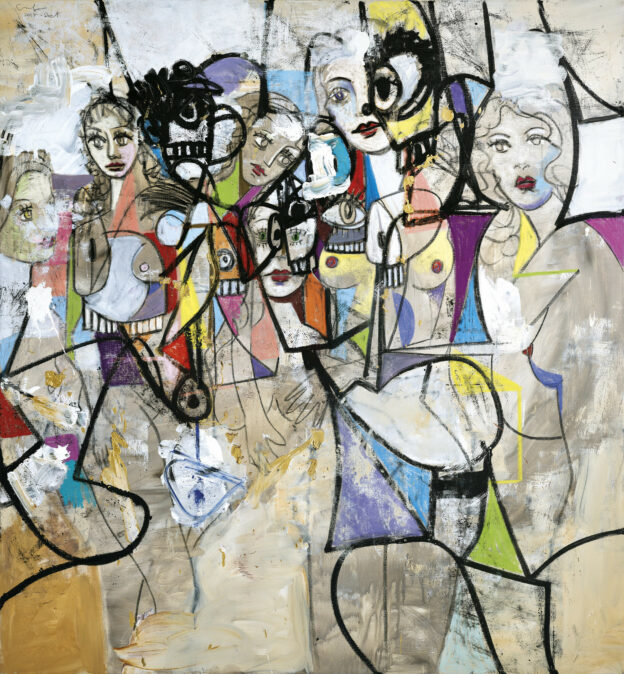Your cart is currently empty!

Shattering the Canvas: How Contemporary Artists Are Rebuilding Cubism for the 21st Century
A Modern Revival of Cubism
Cubism. The very word conjures up fragmented forms, multiple perspectives, and a radical break from traditional representation. Born in the early 20th century studios of Pablo Picasso and Georges Braque, Cubism didn’t just depict the world differently—it fundamentally reconstructed how we see it. But is this revolutionary movement just a relic of art history? Absolutely not. Today, Cubism is experiencing a vibrant resurgence, with contemporary artists not merely echoing the past but boldly reshaping it for our modern world.
A Quick Glance Back: What Was Cubism, Anyway?
For those needing a refresher, Cubism was a rebellion against the illusion of three-dimensional space on a two-dimensional canvas. Artists like Picasso and Braque, tired of simply mimicking reality, dissected objects and figures into geometric forms, presenting them from multiple viewpoints simultaneously. Imagine seeing all sides of a face, a building, or a guitar at once, flattened and rearranged into a dynamic, almost puzzle-like composition. This approach, developed in stages from Analytical to Synthetic Cubism, wasn’t about photographic realism—it was about exploring the very essence of form, space, and perception itself.
A Pioneering Female Voice: Marie Laurencin
While Cubism is often associated with Picasso and Braque, other artists contributed significantly to its development. Among them, Marie Laurencin stands out as a pioneering female voice within the movement. Working in Paris during the height of Cubism, Laurencin developed a distinctive style that incorporated Cubist principles but with a softer, more lyrical sensibility. Her pastel-colored, flowing compositions—often depicting women—challenge the rigid, angular style of traditional Cubism. Laurencin’s work highlights the diversity within the movement and serves as a precursor to the contemporary female artists re-energizing Cubism with fresh perspectives today.
Why Cubism Still Resonates in the 21st Century
With digital art, hyperrealism, and countless new mediums at their disposal, why are contemporary artists returning to Cubism? The answer lies in the movement’s enduring power to reflect and engage with modern realities.
Fragmentation in a Fragmented World
Our contemporary experience is inherently fragmented. We live in an age of information overload, fractured identities, and constantly shifting perspectives. Cubism, with its deconstruction and reassembly of forms, speaks directly to this sense of modern fragmentation. It mirrors our digital age, where we consume content in bits and pieces, constructing meaning from disparate parts.
Challenging Perspectives—Literally and Figuratively
Cubism’s core principle of multiple viewpoints remains incredibly relevant in a time that demands the recognition of diverse perspectives. Contemporary artists are using Cubist techniques to explore identity, cultural hybridity, and social commentary, offering multifaceted viewpoints on complex subjects.
Beyond Representation
In an era saturated with images, artists are seeking ways to move beyond simple representation. Cubism, with its emphasis on abstraction and conceptual exploration, provides a powerful framework for delving into deeper ideas, emotions, and experiences rather than just mirroring the surface of reality.
Meet the New Cubists: Artists Reimagining the Fragmented Form
Several contemporary artists are taking Cubism’s legacy in exciting new directions. Here are a few who stand out:
Here are five contemporary artists who are reinterpreting Cubism for the 21st century:
1. Farah Atassi (France-Syria)
Atassi modernizes Cubism with vibrant geometric patterns and structured compositions. Her work, influenced by Synthetic Cubism, incorporates bold colors, decorative elements, and architectural references, creating dynamic and abstract spaces.
2. George Condo (USA)
A major figure in contemporary art, Condo fuses Cubist deconstruction with pop culture and surrealism. His fragmented, exaggerated portraits recall Picasso’s Cubist distortions while adding a modern, satirical edge.
3. José Parlá (USA-Cuba)
Blending Cubism with graffiti and abstract expressionism, Parlá creates layered compositions that reflect urban landscapes. His textured paintings evoke the fragmented perspectives of Cubism while incorporating calligraphy and street art influences.
4. Akea Brionne Brown (USA)
Brionne Brown reimagines Cubism through digital collage and contemporary portraiture. She explores themes of Black identity and memory, using fractured forms to tell complex personal and historical narratives.
5. Tahnee Lonsdale (UK-USA)
Lonsdale’s work features fragmented, abstracted figures rendered in rich, earthy tones. Her Cubist-inspired approach conveys themes of identity, resilience, and the emotional depth found in broken yet interconnected forms.
These artists prove that Cubism remains a powerful visual language, continuously evolving to reflect the complexities of our modern world.
Themes Emerging from the Contemporary Cubist Canvas
By examining these artists and others working in similar veins, some key themes emerge:
Feminist Reclamations
Many female artists are using Cubism to reclaim representation and challenge the historically male-dominated narrative of the movement. Through fragmentation, they explore female identity, the female gaze, and deconstruct traditional portrayals of women in art.
Identity and Hybridity
Cubism’s ability to represent multiple perspectives makes it a powerful tool for exploring complex identities. In an increasingly globalized world, artists use Cubist techniques to reflect hybrid cultural experiences, layered identities, and the fluidity of self in the modern age.
Digital Echoes
The fragmented, multi-perspectival nature of Cubism resonates with our digital experiences. From social media feeds to the constant stream of online information, our lives are mediated through fragmented digital interfaces. Contemporary Cubist art often reflects or critiques this digital reality.
The Future is Fragmented—and Fascinating
Cubism, far from being a closed chapter in art history, remains a living, breathing language that continues to evolve. Today’s artists are not simply imitating Picasso and Braque; they are taking Cubism’s core principles—fragmentation, multiple perspectives, abstraction—and applying them to new mediums, new themes, and new ways of seeing the world.
The result is a vibrant and relevant art form that speaks directly to the complexities of 21st-century experience. The next time you encounter a painting that seems to break apart and reassemble before your eyes, remember: Cubism is not just the art of the past—it is a powerful lens for understanding our fragmented present and imagining a multifaceted future.
Recommend0 recommendationsPublished in Artists insights, Uncategorized
Leave a Reply